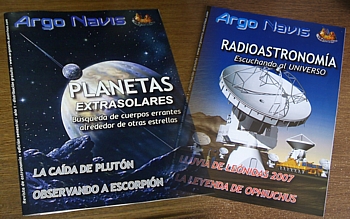Context of this publication
![]() Argo Navis was edited by a team made up of amateur astronomers, motivated by their enthusiasm and passion for astronomy, who saw in this publication an instance of useful dissemination to the amateur community, both Chilean and Spanish-speaking.
Argo Navis was edited by a team made up of amateur astronomers, motivated by their enthusiasm and passion for astronomy, who saw in this publication an instance of useful dissemination to the amateur community, both Chilean and Spanish-speaking.
Because the Argo Navis team in its original version is based within the Antofagasta region (Chile), the magazine has several contents directed/related to this location. In any case, these contents may also be of interest, due to the relevance of northern Chile as a world-renowned place for astronomy.
Why Argo Navis?
Famous in mythology, Argo Navis was a Greek ship in which Jason and the Argonauts went in search of the mythical Golden Fleece. Thousands of years ago it formed a single gigantic constellation in the southern sky, but it was later divided into 4 that correspond to the main parts of the ship: Carina (the Keel), Puppis (the Stern), Vela (the Sail) and Pyxis (the Compass). This name was chosen because it represents one of the largest constellations of antiquity, in addition to being located in a very southern region of the sky (it can only be seen from the Southern Hemisphere), providing a touch of representativeness to its place of origin.
Print editions #13 and #16 (2007)
 Argo Navis managed to have 2 printed editions during its useful life (print run of 500 units), launched simultaneously with the online editions #13 and #16. This was achieved thanks to funds from the Universidad Católica del Norte (Antofagasta, Chile). These units were distributed in educational centers in the Antofagasta region, amateur groups and astronomical institutions in the country.
Argo Navis managed to have 2 printed editions during its useful life (print run of 500 units), launched simultaneously with the online editions #13 and #16. This was achieved thanks to funds from the Universidad Católica del Norte (Antofagasta, Chile). These units were distributed in educational centers in the Antofagasta region, amateur groups and astronomical institutions in the country.

